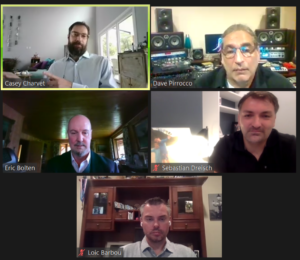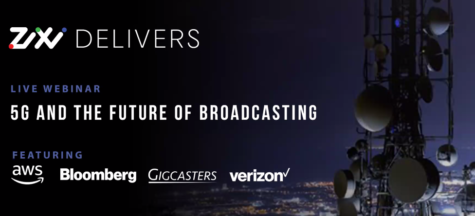Connections

Zixi, AWS and Verizon Tout the Benefits of 5G
Story Highlights
Zixi, Amazon Web Services (AWS) and Verizon representatives used a webinar on Sept. 23 to highlight the benefits of 5G and the significant role each company is playing in the promotion and rollout of the fifth-generation mobile technology.
“From the Zixi perspective, we tend to see the world and the new media landscape in what we’re terming the Four Cs, and that’s: Content, the carrier (Verizon being a main player), the cloud (Amazon being a main player) and cellular, Eric Bolten, VP of business development at Zixi, said while moderating the Zixi-hosted webinar “5G and the Future of Broadcasting.”
“I think the big question” everyone is asking is: ‘How does this relate within the television broadcast context and how ready is it?’ he pointed out.
“At the end of the day, the technology is wonderful, but it’s about the business objectives and what are you going to achieve and speed to market and the agility that comes with this,” he said.
Dave Pirrocco, distinguished architect at Verizon Enterprise Solutions, and Sebastian Dreisch, global head of AWS Wavelength, went on to explain the significant impact 5G stands to have on the way content services are delivered and operated, while pointing to the lower latency delivery, extreme programmability with software-defined video platforms, virtualized cloud-based infrastructures, and advanced overall quality of service (QoS) and (QoE) that 5G provides to broadcasters.
They discussed the opportunities – and also some of the challenges — facing broadcast media as the industry prepares for 5G-enabled Internet Protocol-based distribution models for live video.

Verizon
“Where we are today is we have 5G Ultra Wideband [service] launched in 33 cities,” Pirrocco noted.
He also pointed out that, one day earlier, his company and Verizon Edge partner AWS announced the addition of three more 5G mobile edge computing (MEC) cities where businesses and developers can build and deploy applications with AWS Wavelength at Verizon’s 5G Edge: Atlanta, New York and Washington, DC. Verizon and AWS launched the MEC platform in August in Boston and the Bay Area.
“That brings the total live cities for that component of this whole ecosystem to five,” Pirrocco said, adding: “We’re committed to five more by year end.”
Meanwhile, Verizon has an “ongoing project in terms of density and in terms of deployment,” he said, pointing to its Fiber One initiative, which is “considered one of the largest construction projects in the country,” and calls for it to “build out the dense fiber assets that we need to deliver what we’re talking about here everywhere.”
Describing the “hyper low latencies” for broadcasting that will be possible using 5G, MEC and a media gateway, he noted 20-40 milliseconds is possible vs. a typical 5-7 second lag with satellite distribution now.
“Network slicing is definitely a big part of the promise of 5G” also, he said, referring to the network architecture that allows for the multiplexing of virtualized and independent networks using the same physical network infrastructure.
“When you think of having discrete slices for discrete purposes, that becomes a big deal” with 5G able to “support massive amounts of devices,” he explained. While in the 4G arena, “you start to see performance degradation as you get a dense user base…. with 5G and with slicing, [Verizon is] able to supply a larger consumer base,” he noted.

AWS
In the media and entertainment sector, AWS has been hearing demand for lower latency for a long time, Dreisch said, noting how “valuable” a centralized AWS cloud is in providing that.
“With 5G we get that step function improvement when it comes to throughput and latency but by bringing AWS closer on the back end as well, we can enable brand new use cases” that include “in-stadium experiences, video production, media gateways and video streaming,” he said.
And with the AWS cloud, “you don’t need to bring on-premises servers into all these locations anymore” and get tools including application programming interfaces (APIs) and AWS services “that our customers leverage,” he said, adding: “That’s where I’m excited that AWS can contribute to the ecosystem and help – and obviously without 5G it wouldn’t be possible – but help our customers leverage these new technologies and [offer] either brand-new, immersive, nascent things that don’t even exist yet or do the things that they have done in the past much, much easier.”
There are “many use cases, but [it is] still pretty targeted in specific verticals that look at this as a huge opportunity,” he said.
M&E use cases include video game streaming, he noted, pointing out that, on mobile devices using a mobile network now, the game streaming experience is not always acceptable to gamers. However, edge computing can significantly improve the mobile gaming experience and allow games to be processed locally on devices that would otherwise not be able to support it, he said.
There is also a “huge opportunity in M&E to do 360, 180-degree video, immersive experiences – thing that just otherwise …. would be very complex to achieve” without 5G, he added.
Low Latency
Bolten asked the time frame in which we can expect to get 5G latency down to the sub 30-millesecond range.
“From the cloud processing standpoint [using the] cloud switching model…. 30 milliseconds end to end is going to be pretty tough, I would say, for the next 12 months, including all application layers,” according to Casey Charvet, managing director of digital video technology and engineering services company Gigcasters.
However, he added: “After 12 months, I think we might start to see some numbers closer to that.”









